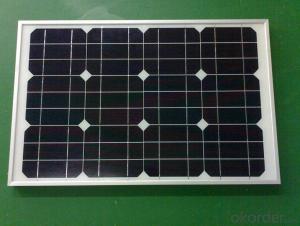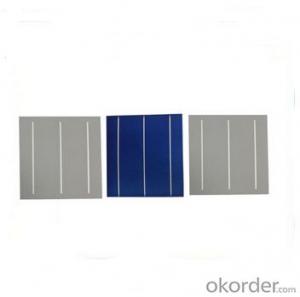Carbon Nanotubes Solar Cells 156mm*156mm B Grade Low Price
- Loading Port:
- Shanghai
- Payment Terms:
- TT or LC
- Min Order Qty:
- 30000 pc
- Supply Capability:
- 1000000 pc/month
OKorder Service Pledge
OKorder Financial Service
You Might Also Like
Product description
Solar Cells 156mm*156mm B Grade Low Price
A solar cell, or photovoltaic cell, is an electrical device that converts the energy of light directly into electricity by the photovoltaic effect, which is a physical and chemical phenomenon.[1] It is a form of photoelectric cell, defined as a device whose electrical characteristics, such as current, voltage, or resistance, vary when exposed to light. Solar cells are the building blocks of photovoltaic modules, otherwise known as solar panels.
Solar cells are described as being photovoltaic irrespective of whether the source is sunlight or an artificial light. They are used as a photodetector (for example infrared detectors), detecting light or other electromagnetic radiation near the visible range, or measuring light intensity.
In contrast, a solar thermal collector supplies heat by absorbing sunlight, for the purpose of either direct heating or indirect electrical power generation from heat. A "photoelectrolytic cell" (photoelectrochemical cell), on the other hand, refers either to a type of photovoltaic cell (like that developed by Edmond Becquerel and modern dye-sensitized solar cells), or to a device that splits water directly into hydrogen and oxygen using only solar illumination.
Advantage Of Solar Cells 156mm*156mm B Grade Low Price
1: High quality cell, Level A cell (14%—17.5%)
2.Dimensione:156*156mm Diagonal:200mm
3: Qualified certification: TUV,CE certification.
4: Warranty: five years for whole unit
Usage/Application Of Solar Cells 156mm*156mm B Grade Low Price
1.The absorption of light, generating either electron-hole pairs or excitons.
2.The separation of charge carriers of opposite types.
3.The separate extraction of those carriers to an external circuit.
Product Images



Electrical Characteristic
Efficiency (%) | Pmpp (W) | Umpp (V) | Impp (A) | Uoc (V) | Isc (A) | FF (%) |
17.25 | 4.197 | 0.524 | 7.992 | 0.62 | 8.458 | 80.03% |
17 | 4.137 | 0.524 | 7.876 | 0.619 | 8.353 | 80.01% |
16.75 | 4.076 | 0.522 | 7.81 | 0.617 | 8.286 | 79.73% |
16.5 | 4.015 | 0.518 | 7.746 | 0.613 | 8.215 | 79.73 |
16.25 | 3.955 | 0.515 | 7.683 | 0.61 | 8.144 | 79.61% |
16 | 3.894 | 0.512 | 7.613 | 0.608 | 8.075 | 79.31% |
15.75 | 3.833 | 0.51 | 7.534 | 0.605 | 8.058 | 78.62% |
15.5 | 3.772 | 0.508 | 7.453 | 0.604 | 8.02 | 77.87% |
15.25 | 3.771 | 0.505 | 7.35 | 0.604 | 9.997 | 76.83% |
15 | 3.65 | 0.503 | 7.271 | 0.604 | 7.989 | 75.64% |
14.5 | 3.529 | 0.499 | 7.067 | 0.604 | 7.988 | 73.14% |
14 | 3.407 | 0.499 | 6.833 | 0.604 | 7.833 | 72.01% |
Intensity Dependence
Intensity [W/m2] | Isc× [mA] | Voc× [mV] |
1000 | 1.00 | 1.000 |
900 | 0.90 | 0.989 |
500 | 0.50 | 0.963 |
300 | 0.30 | 0.939 |
200 | 0.20 | 0.920 |
Packaging & Delivery Of Poly Solar Cell 156mm | |
Packaging Detai | Packaging Detail:Export Carton and Pallet or under customer request. |
Delivery Detail:10-20days | |
FAQ
Q:What price for each watt?
A:It depends on the quantity, delivery date and payment terms
Q:What is your warranty system?
A:Our Solar cells performance guarantees for 25 years
Q:How do you pack your products?
A:We have rich experience on how to pack thecells to make sure the safety on shipment when it arrives at the destination.
- Q: Can solar cells be used in greenhouses or agricultural facilities?
- Yes, solar cells can be used in greenhouses or agricultural facilities. Solar panels can be installed on the roofs or walls of these structures to harness the sunlight and convert it into electricity. This renewable energy source can power various operations such as lighting, ventilation, irrigation systems, and even machinery, reducing reliance on fossil fuels and promoting sustainability in the agricultural sector. Additionally, solar cells can help offset energy costs and enhance the overall environmental friendliness of these facilities.
- Q: How can the solar power change our life by using solar cells material?
- 100 years ago, no human being could ever dare to imagine that we can use solar cells to generate solar power to better change our life. Today it is happening everyday!
- Q: What is the role of disconnect switches in solar cell systems?
- Disconnect switches in solar cell systems serve as a crucial safety measure by providing a means to isolate the solar panels from the electrical grid. They allow for the safe maintenance, repair, or replacement of solar components without the risk of electrical shock or damage. Additionally, disconnect switches enable efficient troubleshooting and troubleshooting of solar systems by allowing technicians to isolate specific sections of the system for inspection or repair.
- Q: Can solar cells be used in countries with limited sunlight?
- Yes, solar cells can still be used in countries with limited sunlight. While solar cells are most efficient in areas with abundant sunlight, they can still generate electricity even in regions with limited sunlight. Advances in technology have made solar cells more efficient and capable of capturing and converting sunlight into electricity even in low-light conditions. Additionally, solar cells can be combined with battery storage systems to store excess energy generated during sunny periods for use during cloudy or nighttime hours. Thus, solar cells can be a viable and sustainable energy solution in countries with limited sunlight.
- Q: How are solar cells connected in a photovoltaic system?
- Solar cells are connected in a photovoltaic system through series and parallel connections to form strings and modules, which are then connected to inverters to convert the generated DC electricity into AC electricity for use in homes or businesses.
- Q: Anybody ever heard of thin film solar cell? What it that?
- I did hear that term once, but can't remember what it is.
- Q: My solar cells are broken, can I just buy one and replace it?
- It's a bit risky to do that by yourself.
- Q: Can solar cells be used to power large industrial facilities?
- Yes, solar cells can be used to power large industrial facilities. With advancements in solar technology and the availability of large-scale solar installations, solar power has become a viable option for industrial-scale electricity generation. By deploying a sufficient number of solar panels, along with efficient energy storage systems, it is possible to meet the energy demands of large industrial facilities and reduce their dependency on conventional power sources.
- Q: Can solar cells be used in desalination plants?
- Yes, solar cells can be used in desalination plants. Solar energy can be harnessed by solar cells to power the desalination process, making it a sustainable and environmentally friendly approach. The solar cells can generate electricity to run the desalination equipment, such as reverse osmosis systems, efficiently converting saltwater into freshwater.
- Q: Can solar cells be used in agricultural irrigation systems?
- Yes, solar cells can be used in agricultural irrigation systems. Solar-powered irrigation systems use solar panels to convert sunlight into electricity, which can then power pumps or other irrigation components. This renewable energy source can help reduce reliance on fossil fuels and provide a sustainable solution for irrigation in agricultural settings.
Send your message to us
Carbon Nanotubes Solar Cells 156mm*156mm B Grade Low Price
- Loading Port:
- Shanghai
- Payment Terms:
- TT or LC
- Min Order Qty:
- 30000 pc
- Supply Capability:
- 1000000 pc/month
OKorder Service Pledge
OKorder Financial Service
Similar products
Hot products
Hot Searches
Related keywords


























